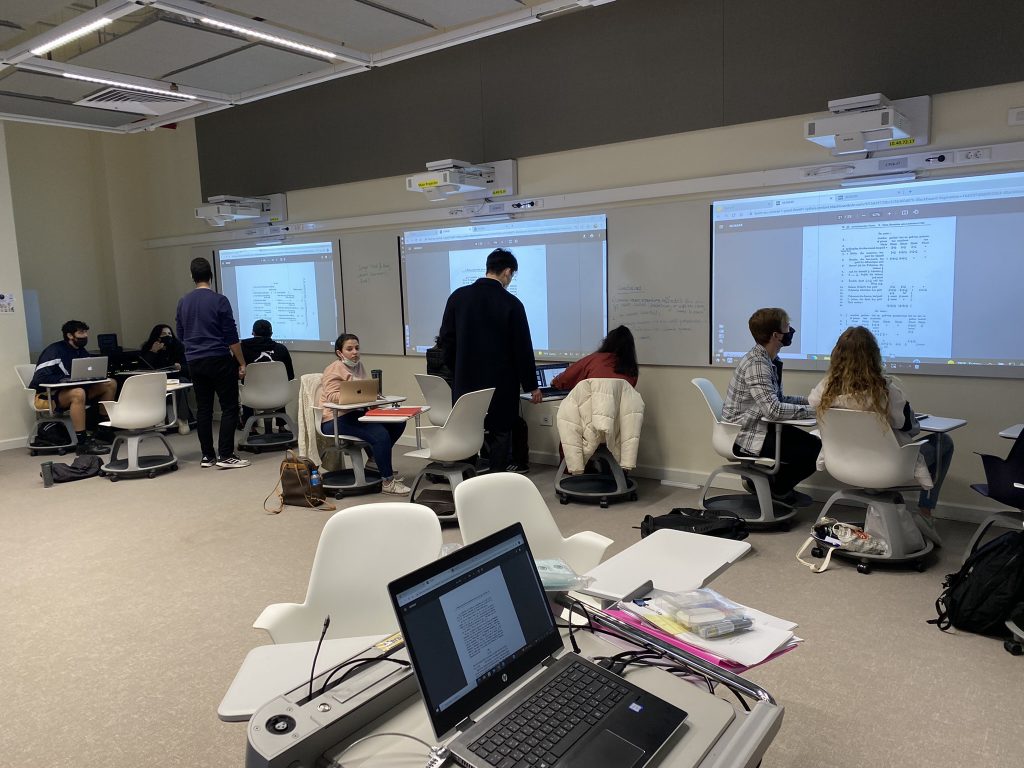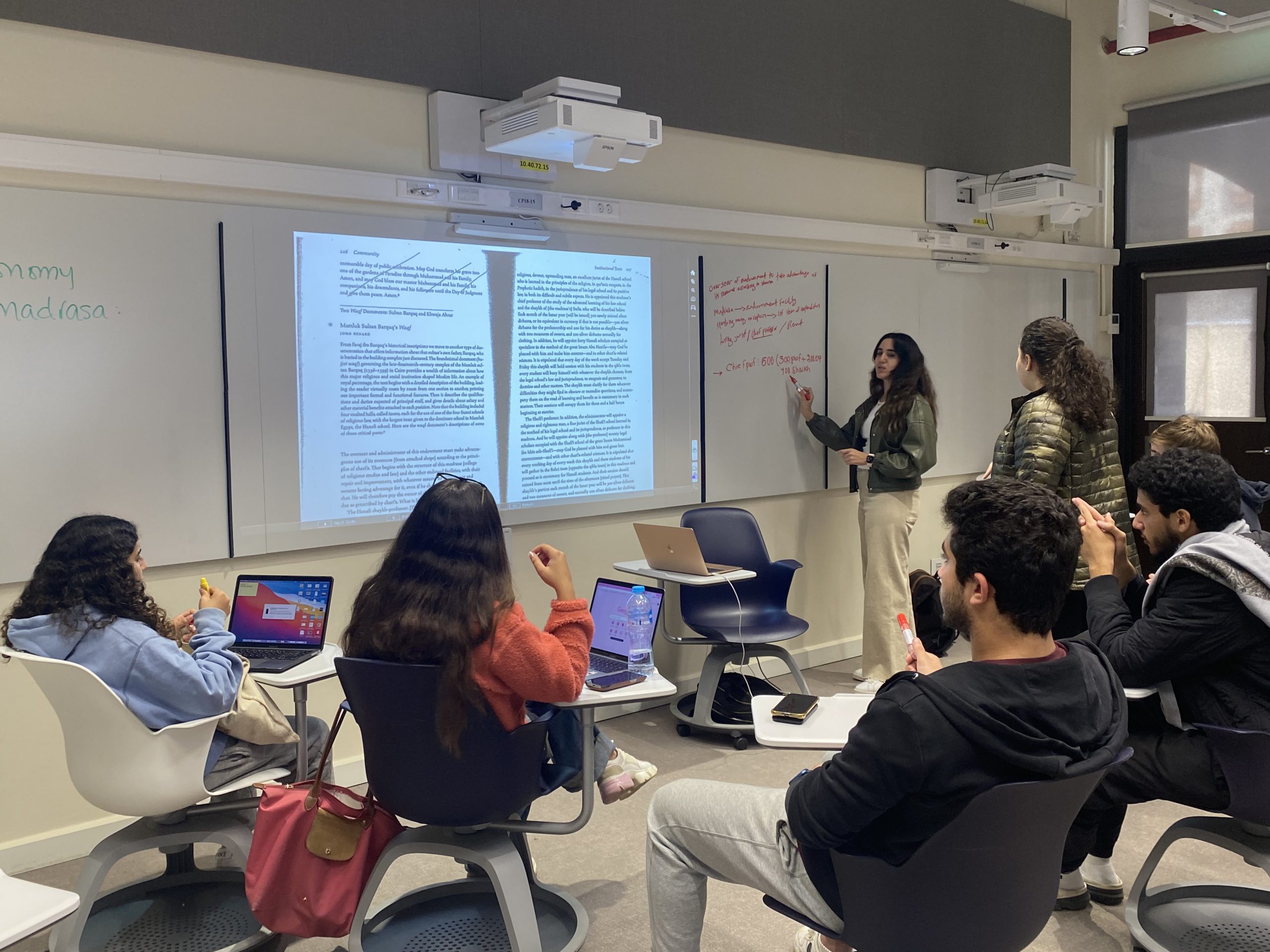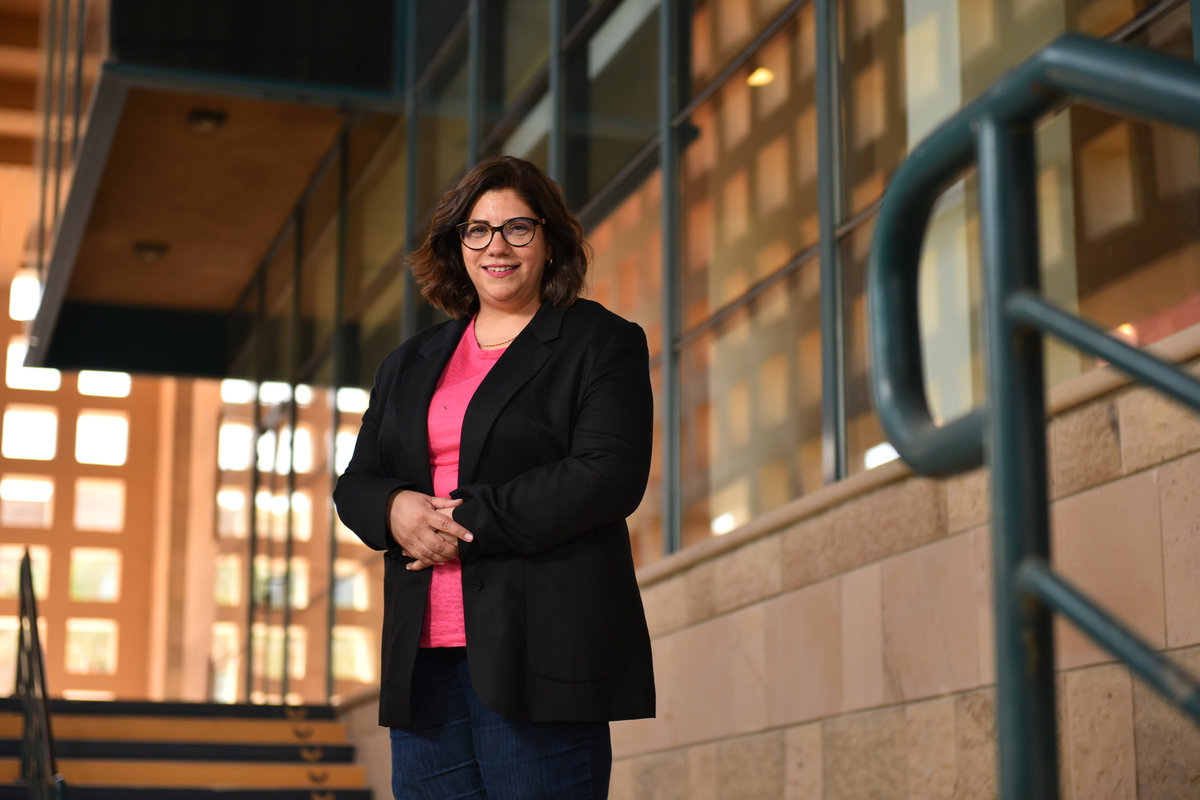Three years ago or so I was invited to several brainstorming sessions and workshops by the Taskforce on Learning Spaces at AUC. At one of those events we met with consultants who gave us various opportunities to redesign and design from scratch new learning spaces around the AUC campus. The sky was the limit. But the sessions also involved imagining how we would use these spaces in our teaching, and how that would be different from -hopefully also better than- what we were currently doing.
I was more than a little excited, therefore, when upon returning from the remote teaching of Covid-19 in Fall 2021 we were met with some pilot “Active Learning Classes” which were set up on campus to try out some of the ideas we had brainstormed about. I was lucky to be selected as one of the faculty to try out those pilot classrooms.
In my mind, and in conversations with friends, I often referred to the classrooms as one of the very nice easter eggs-type surprises of returning to campus. I spoke of teaching in “smart classrooms”, “fancy classrooms,” “high-tech classrooms,” etc. It was always about the “classrooms.”
Let me describe some of those classrooms for you. Some have carpeting and others have smoother floor material; they have fabric panels on the ceiling that together absorb some of the noise and echo. They have very nice “node chairs” with built-in writing tables and wheels that move smoothly on the carpet or floor and curtains that help minimize the distraction from the outdoors and the light that can interfere with film screenings.
There’s also new technology in those rooms. It was a bit challenging learning to use smart screens, with multiple projectors in the classroom (the pilot rooms have two, six or eight projectors) which can be all employed at the same time, to project the same or different material.
Yet it’s only this semester, as we go through another round of the pilot, that the project and (some) of its capabilities have finally sunk in. It’s not about the rooms; it’s about the choices they give us in teaching and how students learn in them. Hence, the “Active Learning Classrooms” label. Hence, also, the title of this column. I know! I know! It should have been obvious, but, as every teacher knows, things take time to sink in; learning takes time. It also needs intentionality.
I teach Islamic history. This sounds very interesting or very archaic to some, but it also means I get students with various degrees of background, and all sorts of entrenched preconceived ideas about that past. One of my main learning outcomes across the different levels of courses is for students to learn to critically read both primary (historical) sources and secondary (modern studies) sources and to develop their own arguments and conclusions about the past— to construct their own narratives about this past. One of my main objectives is that students understand that history (with a small “h”) is the narratives that people like them construct about the past.
To do this, I introduce students to different texts and especially to primary source material which can be intimidating to them at first. These historical sources include different types of documents and texts, written in different registers of language for different purposes (chronicles, memoirs, biographies, hagiographies, marriage contracts, receipts, petitions to rulers, court registers) and we read them in English translations, so all of this is sometimes bewildering to students. They just want a straight story, and I’m trying to show them the raw material, the building blocks, and ultimately the cracks and seams in the stories. Usually, they just don’t know where or how to start. So I like to do hands-on exercises in class to show them how to read and unpack such sources and get over the block.
I introduce them to a selection of a primary source and ask them to read it and answer some questions about it. These can be factual questions, especially with lower-level classes: Who is the author? What is their perspective? Can we date this source? Or analytical questions: how does the author represent this or that? What can we read between the lines? How does this source, let’s say the Chronicle of John of Nikiu, compare with the history of Ibn ‘Abd al-Hakam?
What I Used To Do Before
In the past, I did this exercise with the class as a whole, with me leading the exercise, occasionally asking one of the students to read out loud some sentences to the class and then posing myself the questions to all of them and have some of them answer by raising their hands.
Several times in a semester, I would divide them in groups of four or five students, and assign each group a short selection of a text along with a set of questions for things to find in the text. I would prepare handouts of those texts, a copy for each group, or copies for each member of the group. The result was that ultimately, though they sat in groups, they were each bent over their sheet, reading alone. Then after some minutes of this, they might be prodded to discuss the material together as a group and prepare their collective answers to the questions. We would then regroup as a class and each group would present what its source discusses and what they were able to deduce. It worked well enough and often students would comment favorably on it at the end of semester and evaluations, but I could only do it a few times a semester. It needed a different type of preparation, copies of the material, and also it takes a good time from the class to rearrange the tables and chairs in group format.

How the Classrooms Transformed: The Active Learning
The new classrooms have allowed me to redesign this type of exercise and to do it more frequently, often once a week. Again, I divide the students into groups. Depending on the size of the class that day and the nature of the documents, I either divide them into two or four groups. The node chairs allow the students to quickly and smoothly slide to semi-circles around each of the screens.
After I divide them in groups, each group is given a text which I then arrange to have on one of the screens in the room. The addition of multiple screens and projectors in the classroom allows me to show different material on each screen sometimes or to have all groups read the same material. I have used either static screen shots of the texts or having students connect through different devices.
I then ask them to read each text, usually with one or two guiding questions that I ask them to answer collectively. They are given colored markers and asked to annotate the text and write key words and answers to those questions. They highlight key sentences or phrases in the texts. Sometimes I would ask them to color code the findings (so economic insight in green, political insight in blue etc). Other times I ask each group to read from a different angle. For example, we were recently reading a translation of a waqf (pious endowment) document that supported a madrasa (institution of higher religious studies, a university) and one group was reading to deduce information about the system of education in the madrasa while the other group was reading to understand the economy of the madrasa. The infrastructure of the active learning/active teaching classrooms helps the students really do this in a group. With the smart screens they actually do read together, more or less at comparable paces, and they can all see the comments each one makes on the board/screen right away.
This achieves my goals of having them work together much better than the conventional method. I have noticed that the setup also makes them more animated. They get up to write on the board, use the colored markers, make notes, and they are generally more energetic.
The markers and the setup empower many of them at the same time. They physically get up and move to the board and back to their chairs, they congregate around the screen and talk out loud with each other. The fact that they are all reading off the same screen makes reading less solitary. The energy is much different and is heartening to see. They end up wondering, discussing, questioning, together, what a text might mean, how this section or this sentence connects to another. Sometimes I’ll ask some of them who have their laptops with them to assist by checking more facts to supplement the analysis: a biography of the author perhaps, or the dates and context of a particular event that’s mentioned in the text.
The setup of the classroom also allows me to move easily between the different groups and see what they’re doing without necessarily interrupting them. I am part of their group discussions, but I am not their center. I am not physically at its center either.
There is something of a redistribution of authority in those exercises, an empowering of the students. It’s heartening to see some of the quieter students get up and write something on the board, others come alive and can’t stop “playing teacher” before the white board/smart screen.
Depending on the texts we are reading, after about 20 minutes, we come together as a class, and the small circles of chairs are formed into a bigger circle and the class discusses the different texts together, each group sharing their analysis and findings. In that case, each student can also easily see the text the other groups were working on, and can read sections of it and can read the notes they made on their board. So it is easier to have the general class discussion. I often continue the class teaching in the round, physically sitting on a node chair in the circle next to the students, or else moving around the center of the class, but not at its front. Breaking the authority that comes from standing at the front of the class alone with rows of students looking up to me/at me (a set-up that is eerily similar to religious ritual set-ups), maintains a different energy in the room, it defuses authority and subtly empowers students to consider their own opinions and arguments and to speak up. The energy is palpable.
It’s not always rosy and there are still days when the classroom is slow. Midterm period of the semester is tough, the students are usually tired and too distracted. On days when some of the more active students are absent, you can feel their missing energy.
It’s important not to be simply driven by the technology and to reflect regularly on its use. In the case of our classrooms this for example can mean deciding whether and how many projectors to use in a given lesson and to what aim. For if it’s not used effectively the technology can be distracting. In that regard the PICRAT model is quite useful. It aims to identify the effects of technology on both students and faculty:
PIC (passive, interactive, creative) refers to the student’s relationship to a technology in a particular educational scenario. RAT (replacement, amplification, transformation) describes the impact of the technology on a teacher’s previous practice. (Kimmons et al, 2020)
I am scrambling to learn as I develop this and as I move from the expectation of replacing some exercises with others, to the idea of transforming the class experience entirely to encourage student creativity in learning. I am needing to redesign my syllabus and lesson plans to match this type of teaching – something I hadn’t anticipated. For these exercises to work, and with the kinds of texts I use, students ideally need 20-30 minutes of group time, and then we regroup and discuss. So when I want to use multiple texts and we are reading them carefully and closely, this could take up the entire class session. What this means is that we might end up covering less material throughout a given module and ultimately throughout the semester, but we might cover it more deeply. Retention of material discovered by self-discovery and self-learning is generally higher. And I have noticed this on the assignments that students submit. Therefore, I need to redesign my syllabuses with that in mind and to make some new choices: which things need more hands-on studying and work and which things, readings or whole topics, can be sacrificed for the greater good of achieving the main learning outcomes of the course.
In a way these group exercises are allowing me to flip my classrooms. “Flipped classrooms” are often described as having students do some of the learning on their own time and often online and then using the class time to discuss and analyze or practice what they’d already read and learnt, rather than using class time for the professor to dish out the information to them. With AUC undergraduates I have found this type of flipping more challenging. Most of them are not trained to read closely, patiently, slowly. Most have not read a book cover to cover; neither in English nor in Arabic – ever. I find that we benefit more when I hold their hands and do it with them but not for them. In a way these in-class group exercises are a form of flipping but done during the class time and with my guidance.
And I find that students retain more that way. So in conventional assessment exercises, exams or papers, I find that whatever insight had come out in a class exercise where one of them “discovered” that insight, that tidbit often resurfaces in their writing and analysis, more obviously than some of my imbued wisdom. And this is heartwarming because it then means that we have succeeded in the main learning objective (for me at least): showing them practically that history is not mysterious or enigmatic or fixed and closed; that history is what they make of the past. Hopefully, on some other level, they will have learnt that the future is also theirs to make.
Note: I would like to thank Maha Bali for encouraging me to reflect in writing on this experience, and for her continued support.
References
Kimmons, R., Graham, C. R., & West, R. E. (2020), The PICRAT model for technology integration in teacher preparation, Contemporary Issues in Technology and Teacher Education, 20(1). https://citejournal.org/volume-20/issue-1-20/general/the-picrat-model-for-technology-integration-in-teacher-preparationhttps://citejournal.org/volume-20/issue-1-20/general/the-picrat-model-for-technology-integration-in-teacher-preparation/
See also: Kimmons, R., Draper, D., & Backman, J. (2022). PICRAT: The PICRAT Technology Integration Model. EdTechnica: The Open Encyclopedia of Educational Technology. https://edtechbooks.org/encyclopedia/picrat
Disclaimer:
This project is made possible by the generous support of the American people through the United States Agency for International Development (USAID) under the terms of awards Educational Transformation – A Hub for Next Generation Digital Learning Environments at AUC (2020)
& Next Normal Digital Learning Spaces for Educational Transformation (2021). The contents are the responsibility of the Center for Learning and Teaching, American University in Cairo.
Associate Professor and Director of Graduate Studies, Department of Arab and Islamic Civilizations




Amina- thanks for a very engaging reflection on a changed teaching practice: I had the feeling of actual attending your class as I was reading it ( would love to, in fact!) And I agree: just changing the seating arrangement already sets a different mind set for the students, where they are put in charge of their own learning; and of course, using the different screens to present different perspectives at the same time is a great way to show the multiplicity of the historical discourse ( or expose the imposed one-narrative view of it). You make excellent use of the new technology and this is surely appreciated by your students! Technological capacities may take time to develop but weaving them into an pedagogical framework is exciting and refreshing for both, teacher and student. Keep up the great energy!
Thank you Sherin for your encouraging remarks! I just saw them now.